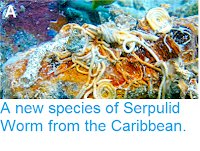Fireworms, Amphinomidae, are Polychaete Worms that are covered in chaetae (bristles) which secrete neurotoxins that produce a painful burning sensation around the area of contact with the skin. Whilst this is a defence intended to deter predators, the Worms are extremely unpleasant to step upon, and the Worms are therefore viewed with some trepidation in areas where they appear. They are particularly problematic as they are prone to undergoing blooms, with vast numbers appearing in an area at the same time, then vanishing as mysteriously as they appeared. One such bloom occurred in the waters around Hong Kong in the summer of 2018, causing problems for many bathers in the area.
In a paper published in the journal Zoological Studies on 10 September 2019, Zhi Wang and Yanjie Zhang of the Institute of Research and Continuing Education, and Department of Biology at Hong Kong Baptist University, Yang James Xie, also of the Department of Biology at Hong Kong Baptist University, and Jian-Wen Qiu, again of the Institute of Research and Continuing Education, and Department of Biology at Hong Kong Baptist University, describe the results of a study that sought to identify the Fireworms involved in the 2019 Hong Kong outbreak.
Wang et al. sampled Fireworms from from Lido Beach and Anglers’ Beach in Tsuen Wan during low tide in June, 2018, and subtidal waters of Tolo Harbour by bottom trawling in August, 2018. These were compared to specimens collected from subtidal sandy bottoms (about 4 m deep) in Port Shelter off Sharp Island during night diving in 2012 and 2017, but not yet analysed.
The Fireworms from the 2018 outbreak were found to belong to the species Chloeia parva, a species apparently widespread in the South China Sea, where it produces periodic outbreaks such as the one recorded. This species has a spindle-shaped body with with around 30 segments, measuring 38 mm to 97 mm long, 8 mm to 20 mm wide excluding chaetae. The species is a pale yellow colour in life, with mid-dorsal 'Y'-shaped dark pigmentation on each segment.
Chloeia parva, living specimen in dorsal view. Scalc bar is 10 mm. Wang et al. (2019).
Sutprisingly, the specimens collected from deeper water in 2012 and 2017 were shown by molecular analysis not to be a reserve from which the 2018 outbreak spawned, but a completely new and previously undescribed species. This is named Chloeia bimaculata, in reference to the to the two mid-dorsal dark spots in each chaetiger (bristle-baring segment). This species has about 30 segments, and is pale in colour with two dark spots arranged one behind the other in each chaetiger. The specimens range from 28 to39 mm in length and from 7 to 14 mm in width.
Chloeia bimaculata, living specimen in dorsal view. Scale bar is 10 mm. Wang et al. (2019).
See also...
Follow Sciency Thoughts on Facebook.








